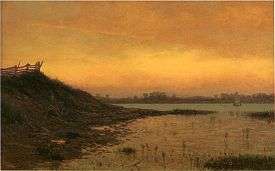James Augustus Suydam
| James A. Suydam | |
|---|---|
 | |
| Born | 1819 |
| Died |
1865 North Conway |
| Alma mater | University of the City of New York |
| Known for | Landscape |
| Movement | Hudson River School; National Academy of Design |
James Augustus Suydam (1819–1865) architect, lawyer, and artist; as an artist was considered one of the premier Luminism painters. He is widely known as an American landscape painter and one of the leading members of the Hudson River School.
Life
James Augustus Suydam was descended from an old New York Dutch merchant family. He graduated from New York University (then the University of the City of New York), and began his career as a businessman but turned a significant portion of his energies to painting, studying under famed artist and portrait painter [1] Minor C. Kellogg.[2] At the age of thirty he was elected to the Century Association.
One of the "regulars" who gathered to paint at North Conway, New Hampshire, he exhibited Conway Meadows at the New York Athenaeum and Boston Athenaeum. He opened his studio at the noted 10th Street Studio Building, New York City, in 1858. The following year he was elected an honorary professional member in the prestigious National Academy of Design, which granted him full membership in 1861. He died suddenly in North Conway at the age of 46.
Assessment

James Suydam was described by his friend, the accomplished artist Sanford Robinson Gifford as a "thoroughly educated and accomplished man."[3] In addition to his work as an artist, which he began only after working in law and architecture, he was widely read and well-versed in history, philosophy, and the sciences. His work as a landscape painter reflects this breadth of knowledge and reveals Suydam as a deeply spiritual individual. Using his familiarity with science, Suydam reduced nature to calm, clean, planar forms, and then distorted proportional relations so that God's creations loomed superior over the work of man.
The National Academy has most of his works such as Paradise Rocks (1865), and the Taft family's Taft Museum also holds works. The Taft also has a podcast website for this artist.[4]
A painting of Gifford's from 1859 which Suydam, according to a report, "donated to the [National] academy in 1865," became the subject of a deaccession controversy at the Academy in late 2008.[5][6]
In 2006, a retrospective was held at the National Academy Museum.[7]
References
- ↑ American Art Colonies, 1850-1930, Steve Shipp (Greenwood Publishing Group, 1996) p. 69.
- ↑ NYU release
- ↑ White Mountain Art biography
- ↑ Taft Museum Web site
- ↑ "National Academy Sells Two Hudson River School Paintings to Bolster Its Finances" by Randy Kennedy, The New York Times, December 6, 2008, p. C1, NY edition. Retrieved 1/13/09.
- ↑ Section on Mt. Mansfield paintings/controversy.
- ↑ Genocchio, Benjamin (September 15, 2006). "A Pioneer of the Poetry in Landscapes". The New York Times. Retrieved 26 March 2013.
External links
- Hudson River school visions: the landscapes of Sanford R. Gifford, an exhibition catalog from The Metropolitan Museum of Art (fully available online as PDF), which contains material on Suydam (see index)
|